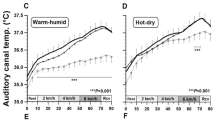Abstract
While some research does exist on wetsuit thermoregulation, there is currently a paucity in the literature describing how various types of neoprene materials affect skin temperatures. The purpose of this study was to test the hypothesis that the slick neoprene would lead to higher skin temperatures in comparison to the jersey material. Participants wore a custom wetsuit with the torso made of half slick and half jersey neoprene materials (n = 78). Participants either participated in one of two field studies or engaged in a simulated surfing session in a flume after sunset, where the influence of direct sun exposure was eliminated. In the field, participants wore four thermistors placed on either side of the chest and the upper back (n = 27) or the abdomen and the lower back (n = 31). Skin temperatures were measured across typical surfing sessions. In the laboratory, the participants (n = 20) wore all eight sensors in the anatomical locations described above, and skin temperatures were recorded across a simulated surfing session. In the field study, the mean skin temperatures under the slick neoprene were significantly higher when compared to the jersey neoprene for the upper chest (p < 0.001), upper back (p = 0.001), and lower back (p < 0.001) at all time points. In the laboratory study, skin temperatures were significantly higher under the slick neoprene at the upper chest and lower back (p < 0.001). These findings may be a result of greater heat absorptive properties of slick neoprene during exposure to the sun and the water-retaining properties of jersey-lined neoprene.





Similar content being viewed by others
Data availability
All data is available upon request.
References
Moran K, Webber J (2013) Surfing injuries requiring first aid in New Zealand, 2007–2012. Int J Aquat Res Ed 7:192–203
O’Brien D, Eddie I (2013) Benchmarking global best practice: innovation and leadership in surf city tourism and industry development. In: Global surf cities conference, kirra community and cultural centre, Coolangatta, Queensland, Australia, January 24
Corona LJ, Simmons G, Nessler JA, Newcomer SC (2018) Characterization of regional skin temperatures in recreational surfers wearing a 2mm wetsuit. Ergonomics 61(5):729–735
Farley O, Harris NK, Kilding AE (2012) Physiological demands of competitive surfing. J Strength Cond Res 26(7):1887–1896. https://doi.org/10.1519/JSC.0b013e3182392c4b
Furr H, Warner ME, Copeland TL, Robles-Rodriguez C, Ponce-Gonzalez JG, Nessler JA, Newcomer SC (2019) Differences in VO2 of surfers when paddling in water vs on a swimbench ergometer. J Strength Cond Res 33(4):1095–1101
Nessler JA, Ponce-Gonzalez JG, Robles-Rodriguez C, Furr H, Warner ME, Newcomer SC (2019) Electromyographic analysis of the surf paddling stroke across multiple intensities. J Strength Cond Res 33(4):1102–1110
Saulino ML, Skillern N, Warner ME, Martinez A, Moore B, Nessler JA, Newcomer SC (2019) Characterization of heart rate response during frontside and backside wave riding in an artificial wave pool. Am J Sports Sci 7(4):136–140
Warner ME, Nessler JA, Newcomer SC (2019) Skin temperatures in females wearing a 2 mm wetsuit during surfing. Sports 7(6):1–8
Coyne JO, Tran TT, Secomb JL, Lundgren LE, Farley OR, Newton RU, Sheppard JM (2017) Maximal strength training improves surfboard sprint and endurance paddling performance in competitive and recreational surfers. J Strength Cond Res 31(1):244–253
Axel TA, Crussemeyer JA, Dean K, Young DE (2018) Field test performance of junior competitive surf athletes following a core strength training program. Int J Exerc Sci 11(6):696–707
McArthur K, Jorgensen D, Climstein M, Furness J (2020) Epidemiology of acute injuries in surfing: type, location, mechanism, severity, and incidence: a systematic review. Sports 8(2):1246–1254
Bergh U, Ekblom B (1979) Influence of musle temperature on maximal strength and power output in human skeletal muscles. Acta Physiol Scandanavia 107:33–37
Sargent AJ (1987) Effect of muscle temperature on leg extension force and short-term power output in humans. Eur J Appl Physiol 56:693–698
Oksa J, Rintamaki H, Rissanen S (1997) Muscle performance and eletromyogram actiity of the lower leg muscles with different levels of cold exposure. Eur J Appl Physiol 75:484–490
Nuckton TJ, Claman DM, Goldreich D, Wendt FC, Nuckton JG (2000) Hypothermia and afterdrop following open water swimming: the Alcatraz/San Francisco swim study. Am J Emerg Med 18(6):703–707
Brannigan D, Rogers IR, Jacobs I, Montgomery A, Williams A, Khangure N (2009) Hypothermia is a significant medical risk of mass participation long-distance open water swimming. Wilderness Environ Med 20(1):14–18
Nimmo M (2004) Exercise in the cold. J Sports Sci 22(10):898–915
Naebe M, Robins N, Wang X, Collins P (2013) Assessment of performance properties of wetsuits. J Sports Eng Technol 227:25–264
How is Yamamoto limstone neoprene made? https://www.seventhwave.co.nz/wetsuits101/Neoprene%2520Info/How%2520is%2520Yamamoto%2520Limestone%2520neoprene%2520made.html. Accessed 6/8/2020
Connolly BJ, Hussey TK (2015) Closed cell materials. United States Patent 8993089, http://www.freepatentsonline.com/8993089.html
Greenhouse SW, Geisser S (1959) On methods in the analysis of profile data. Psychometrika 24:95–112
Benjamini Y, Hochberg Y (1995) Controlling the false discovery rate: a practical and powerful approach to multiple testing. J Roy Stat Soc B 57(1):289–300
Fillingeri D, Morris NB, Jay O (2016) Warm hands, cold heart: progressive whole-body cooling increases warm thermosensitivity of human hands and feet in a dose-dependent fashion. Exp Psychol 102(1):100–112
Acknowledgements
The authors would like to thank the Kinesiology 326 undergraduate students for their help with data collection on this project.
Funding
Not applicable.
Author information
Authors and Affiliations
Corresponding author
Ethics declarations
Conflict of interest
Not applicable.
Ethical approval
All procedures were approved by the Institutional Review Board at California State University, San Marcos (#1302181).
Consent to participate
All prospective participants provided their informed consent prior to participation.
Consent for publication
All authors have approve the submission of this manuscript.
Additional information
Publisher's Note
Springer Nature remains neutral with regard to jurisdictional claims in published maps and institutional affiliations.
This article is a part of Topical Collection in Sports Engineering on Surf Engineering, Edited by Prof. Marc in het Panhuis, Prof. Luca Oggiano, Dr. David Shormann and Mr. Jimmy Freese.
Rights and permissions
About this article
Cite this article
Smith, C., Saulino, M., Luong, K. et al. Effect of wetsuit outer surface material on thermoregulation during surfing. Sports Eng 23, 17 (2020). https://doi.org/10.1007/s12283-020-00329-8
Published:
DOI: https://doi.org/10.1007/s12283-020-00329-8




